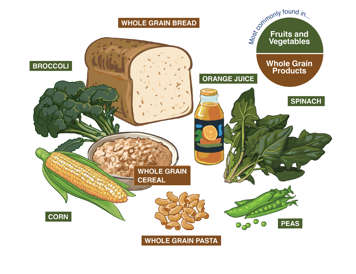What is folate and what does it do?
Folate is another name for vitamin B9. It is important for making blood cells, and it keeps the heart and blood vessels healthy. Folate is essential during early pregnancy to help reduce the risk of some birth defects, such as spina bifida. It is also important for children’s growth.
Sources of folate and how to get enough
Folate is naturally found in many foods. Some foods that are rich in folate include green leafy vegetables, peas, beans, oranges/orange juice and peanuts. There are also some foods that have added folic acid (otherwise known as enriched or fortified foods). Examples of foods that are often fortified with folate include grain products, pasta, and breakfast cereals.
You and your family can get enough folate by eating a variety of these foods throughout the week.
Tips
Overcooking vegetables can reduce the amount of available folate. Try lightly steaming, sauteing or roasting vegetables, or eat them raw.

How much do we need?
Folate recommendations*
| Age | Amount per day (micrograms [µg]/day) |
|---|---|
| Birth – 6 months | 65 µg |
| 7 – 12 months | 80 µg |
| 1 – 3 years | 150 µg |
| 4 – 8 years | 200 µg |
| 9 – 13 years | 300 µg |
| 14+ years During pregnancy During breastfeeding |
400 µg 600 µg 500 µg |
*These recommendations are presented here simply as a guide to help you make informed food choices.
How much folate can I find in a serving of food?
| Examples of food sources | Amount of folate (µg) |
|---|---|
| ½ cup green peas | 47 µg |
| ¾ cup orange juice | 35 µg |
| ½ cup chopped asparagus | 90 µg |
| ½ cup raw spinach | 60 µg |
| ½ cup cooked enriched pasta | 75 µg |
| 30 g peanuts, dry roasted | 27 µg |
Especially important for…
women of childbearing age and in early pregnancy
- Women of childbearing age need a supplement of 400 µg (0.4 mg) folic acid each day in addition to the amount of folate found in a healthy diet.
- Pregnant women should take a multivitamin containing 400-1000 µg of folic acid.
- If you are pregnant, speak to your doctor about the level of folic acid that is appropriate for you if:
- you have a family history of, or a previous pregnancy affected by, an open neural tube defect (for example spina bifida or anencephaly).
- you are on certain medications, including anti-seizure medications.